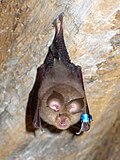Flora and fauna
Fauna
List of fauna found in the sanctuary. [2]
| # | Name | Scientific name | Picture |
|---|---|---|---|
| 1 | Eurasian pygmy shrew | Sorex minutus |  |
| 2 | Leschenault's rousette | Rousettus leschenaultii |  |
| 3 | Lesser horseshoe bat | Rhinolophus hipposideros |  |
| 4 | Greater false vampire bat | Megaderma lyra |  |
| 5 | Java pipistrelle | Pipistrellus javanicus | – |
| 6 | Common bent-wing bat | Miniopterus schreibersii |  |
| 7 | Wall-roosting mouse-eared bat | Myotis muricola |  |
| 8 | Scully's tube-nosed bat | Murina tubinaris | – |
| 9 | Northern plains gray langur | Semnopithecus entellus |  |
| 10 | Rhesus macaque | Macaca mulatta |  |
| 11 | Indian jackal | Canis aureus indicus |  |
| 12 | Asian black bear | Ursus thibetanus |  |
| 13 | Stoat | Mustela erminea |  |
| 14 | Yellow-throated marten | Martes flavigula |  |
| 15 | Masked palm civet | Paguma larvata |  |
| 16 | Jungle cat | Felis chaus |  |
| 17 | Indian leopard | Panthera pardus fusca |  |
| 18 | Southern red muntjac | Muntiacus muntjak |  |
| 19 | Royle's pika | Ochotona roylei |  |
| 20 | Kashmir flying squirrel | Eoglaucomys fimbriatus | – |
| 21 | Red giant flying squirrel | Petaurista petaurista |  |
| 22 | Indian crested porcupine | Hystrix indica |  |
| 23 | House mouse | Mus musculus |  |
| 24 | Kashmir field mouse | Apodemus rusiges | – |
| 25 | Turkestan rat | Rattus pyctoris | – |
| 26 | Lesser bandicoot rat | Bandicota bengalensis |  |
| 27 | Short-tailed bandicoot rat | Nesokia indica |  |
| 28 | Royle's mountain vole | Alticola roylei | – |